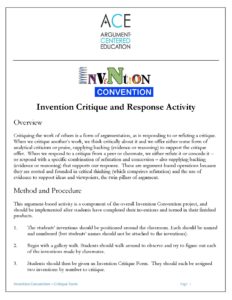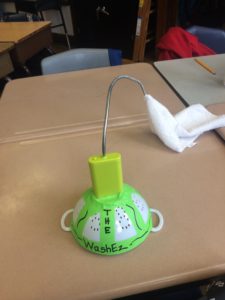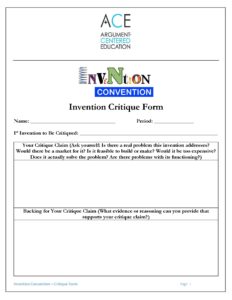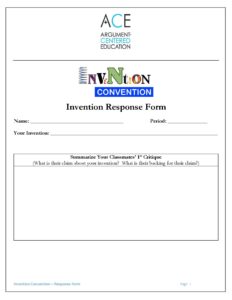
Including Argumentation at the Invention Convention
Invention Convention is an education non-profit in Ohio that sponsors and organizes a STEM program in which (mainly but not exclusively middle school) students use basic principles of engineering and science to create their own invention that addresses a problem or gap in the marketplace that they have observed in their everyday lives. The program’s success is founded on both the practical and hands-on mode in which students actually produce a prototype invention, and of the open-mindedness and creativity that it fosters in students.

Argument-Centered Education has worked to magnify those advantages by designing and including an argumentation component in the project’s implementation with one of our partner middle schools, the Peirce School of International Studies in Chicago. The argumentation component has students think critically about two of their classmates’ inventions and then try to offer respectful critiques of those inventions. The inventors then receive their two critiques, and they prepare a response to each of them. The inventors’ response can be to directly contradict and refute the critique, to concede it and suggest a way that the invention could be modified and improved to address it, or some combination of the two. There is then a class period in which inventors present their responses to the critiques.
The argumentation component builds on and enhances the wonderful Invention Convention project because it requires students to think critically both when looking closely at their classmates’ inventions, and when responding to their classmates’ critiques.

Both the critiques and the responses should of course be based in evidence and reasoning, and they should be formatted in approximately the same ways that other argumentation work that the students perform is formatted. Critiquing the work of others is a form of argumentation, as is responding to or refuting a critique. These are argument-based operations because they are rooted and founded in critical thinking (which comprises refutation) and the use of evidence to support ideas and viewpoints, the twin pillars of argument.

Method and Procedure
This argument-based activity is a component of the overall Invention Convention project, and should be implemented after students have completed their inventions and turned in their finished products.
(1)
The students’ inventions should be positioned around the classroom. Each should be named and numbered (but students’ names should not be attached to the inventions).

(2)
Begin with a gallery walk. Students should walk around to observe and try to figure out each of the inventions made by classmates.
(3)
Students should then be given an Invention Critique Form. They should each be assigned two inventions by number to critique.

(4)
Students should then go to their two assigned inventions and critique them, completing the form for each. Students should go through the questions to try to find some weakness or flaw in the invention, even if they believe that the invention as a whole is a very good one. They should also do their best to supply fact-based evidence and their own analytical reasoning to support each of their critique claims.
(5)
Students should submit their Invention Critique Form. These can be formatively assessed. They then should be distributed to the inventors.
(6)
All students should be given an Invention Response Form. They should complete this form in response to the two critiques that they are given.

(7)
The activity culminates in students presenting their responses to the critiques that their classmates direct to them. They should each present for up to 3 – 4 minutes. Their presentation should include a summary of their own invention – its problem, functioning, and utility – and a summary of the two critiques. Each critique should be followed by the response. Students can submit their Response Form. They can be assessed on both the form and the presentation.
Implementation of this argumentalized project at the Peirce School of International Studies was really very successful. The full fifth grade team there has endorsed the project and was amazed at the level of creativity and ingenuity the kids demonstrated, combined with the deeper thinking and analytical reflection they brought to the STEM-based argumentation component.

